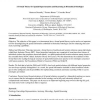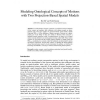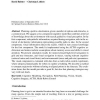50 search results - page 3 / 10 » Modelling Models of Robot Navigation Using Formal Spatial On... |
ICRA
2008
IEEE
14 years 4 months ago
2008
IEEE
— As part of a program to find methods of reducing spatial interference in multi-robot systems, we propose the Interaction Grid (IG), a generalization of the Occupancy Grid that...
ARTMED
2006
13 years 9 months ago
2006
Objective: The objective of this paper is to demonstrate how a formal spatial theory can be used as an important tool for disambiguating the spatial information embodied in biomed...
ICRA
1993
IEEE
14 years 1 months ago
1993
IEEE
An issue central to the navigation problem is memory. Traditional systems build symbolic maps of the world for navigational reference. Reactive methods, in contrast, eliminate or m...
KI
2008
Springer
13 years 9 months ago
2008
Springer
To model human concepts of motions is essential for the development of the systems and machines that collaborate with ordinary people on spatiodynamic tasks. This paper applies two...
CMOT
2010
13 years 7 months ago
2010
Planning a path to a destination, given a number of options and obstacles, is a common task. We suggest a two-component cognitive model that combines retrieval of knowledge about t...



